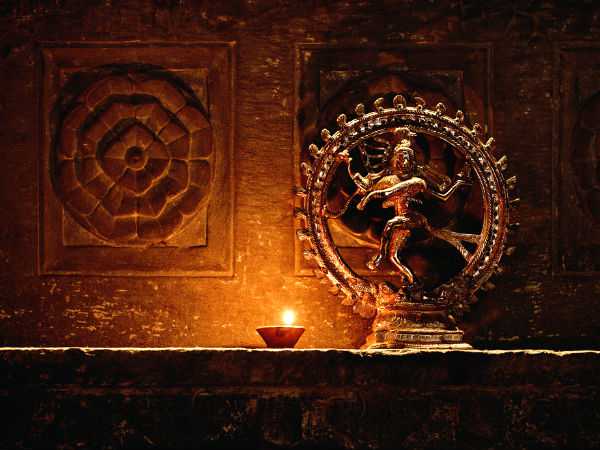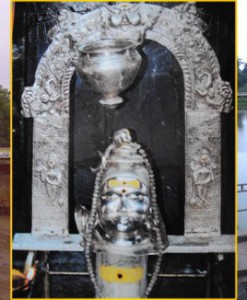No products in the cart.
Thillai Nataraja Temple, Chidambaram or Chidambaram temple is a Hindu temple dedicated to Lord Shiva located in the town of Chidambaram, East-Central Tamil Nadu, South India. The temple is known as the foremost of all temples (Kovil) to Saivites and has influenced worship, architecture, sculpture and performance art for over two millennium.
A major shrine of Lord Shiva worship since the classical period, there have been several renovations and offerings to Chidambaram by the Pallava, Chola, Pandya, Vijayanagara and Chera royals in the ancient and pre-medieval periods. The temple as it stands now is mainly of the 12th and 13th centuries, with later additions in similar style.
The presiding deity of the temple is Lord Shiva. The temple has inspired the famous Nataraj form of the Lord, as a cosmic dancer, one that has now become notably famous in Hinduism. Two other forms of Lord Shiva are represented in the temple, as a lingam – the most common representation of Lord Shiva in temples, and as the aether space classical element, represented with empty space and a garland of fifty one hanging golden vilvam leaves.
The sculptures of Chidambaram inspired the postures of Bharatha Natyam.
Chidambaram is one of the five Pancha Bootha Sthalams, the holiest Shiva temples each representing one of the five classical elements; Chidambaram represents akasha (aether).
LEGEND:
According to legend, the Lord Shiva was strolling through the Thillai Vanam, when he saw a group of rishis. The sages believed in magic and believed that the gods could be controlled by magic and rituals. Lord Shiva walked through the forest, disguised as a Bhikshatana ( a mendicant seeking alms), followed by Vishnu disguised as Mohini, his consort. The sages and their wives were enchanted on seing the beautiful and brilliant mendicant and his consort. The sages were enraged on seing their wives enchanted. They sent a volley of snakes, conjured up with magic, on the mendicant. Lord Shiva just laughed and wrapped the serpents on his neck and waist. The sages proceeded to send a feiorce tiger towards the mendicant. Lord Shiva just killed the tiger and donned its skin around his waist. The sages then sent an elephant. This also, the Lord killed. The Sages then finally conjured up the demon, Muyalakan. The Lord simply smiled, stepped on the demons back and immobilized him. The Lord then performed the Anand Tandav on the demon’s back and revealed his true form. The sages bowed down the Lord and realised that the Lord was beyond magic and rituals.
Thillai Nataraja Temple, Chidambaram
The day starts with the head priest purifying himself and adorning the Shivoham bhava or the shiva hood. The padukas of the Lord are then brought to the temple, in a palanquin, accompanied by loud chanting, cymbals and drums. The priest then performs the puja. The daily pujas are performed 6 times a day. Before each puja, the lingam is anointed with milk, ghee, rice, sandalwood ash. This is followed by offering the deity a variety of food and sweets and then followed by lighting a set of lamps. The puja also includes a recital of the Vedas and the Pancham Puranam . The puja ends with the priest parting the curtains of the sanctum sanctorum to reveal the Chidambara Rahasyam (sanctum).
For the second puja, a ruby idol of the Nataraja is also anointed, along with the lingam.
3rd puja is performed at 12:00 PM.
The temple is then closed till 4:30 PM.
4th puja is performes at 6:00 PM.
5th puja is performed at 8:00 PM.
6th puja is performed at 10:00 PM
After all the pujas are over, the lord’s footwear is taken back in a palanquin, along with a procession, symbolising the Lord’s retirement for the night. It is believed that the entire divine force of the universe retires along with the Lord for the night.
A whole year for men is said to be a single day for the gods. Just as six poojas are performed in a day at the sanctum sanctorum, six anointing ceremonies are performed for the principal deity – Nataraja in a year. They are the Marghazhi Thiruvaadhirai (in December – January ) indicating the first puja, the fourteenth day after the new moon (chaturdasi) of the month of Masi (February – March) indicating the second pooja, the Chittirai Thiruvonam (in April- May), indicating the third pooja or uchikalam, the Uthiram of Aani (June–July) also called the Aani Thirumanjanam indicating the evening or the fourth puja, the chaturdasi of Aavani (August – September) indicating the fifth puja and the chaturdasi of the month of Puratasi (October – November) indicating the sixth pooja or Arthajama. Of these the Marghazhi Thiruvaadhirai (in December – January) and the Aani Thirumanjanam (in June – July ) are the most important. These are conducted as the key festivals with the main deity being brought outside the sanctum sanctorum in a procession that included a temple car procession followed by a long anointing ceremony. Several hundreds of thousands of people flock the temple to see the anointing ceremony and the ritualistic dance of Shiva when he is taken back to the sanctum sanctorum. Lord Shiva, in his incarnation of Nataraja, is believed to have born on full moon day in the constellation of Ardra, the sixth lunar mansion. Lord Shiva is bathed only 6 times a year, and on the previous night of Ardra, the bath rituals are performed on a grand scale. Pots full of milk, pomegranate juices, coconut water, ghee, oil, sandal paste, curds, holy ashes, and other liquids and solids, considered as sacred offering to the deity are used for the sacred ablution.
Natyanjali is a prominent festival celebrated during February every year when Bharatnatyam dancers from all over the country converge to present dance offering to Nataraja.










